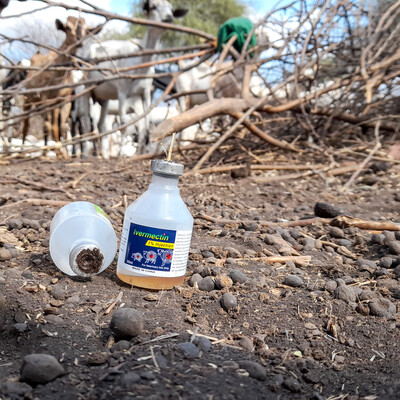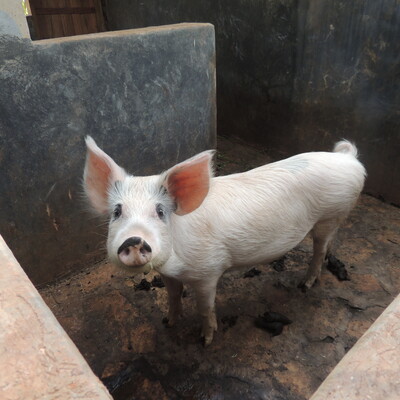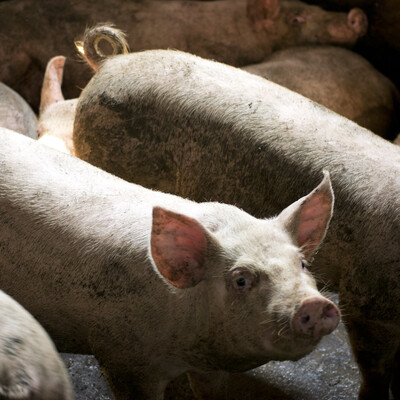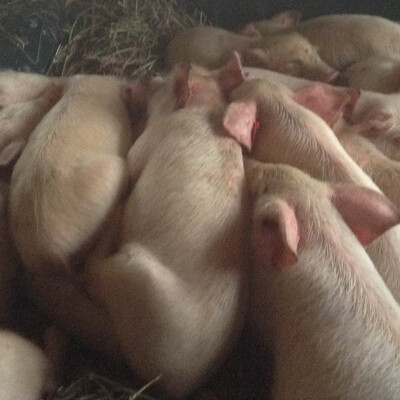
Syndromic e-surveillance: averting livestock disease outbreaks, improving livelihoods

In early 2019, pastoralists in Turkana County lost 675 camels (Camelus dromedarius) with more than 750,000 at risk due to a severe outbreak of the contagious haemorrhagic septicaemia disease. It was not only a costly economic loss, estimated at 33.7 million Kenya shillings (USD337,000) but also a painful loss of livestock the pastoralists have so much social and cultural attachment.
For Mzee Eipah Nacho from Loriamatet Village, Lorongilo Location, Kerio Ward, Turkana County, the 2019 disease outbreak that claimed 10 of his camels was just but a painful reminder of previous devastating outbreaks such as the Peste des petits ruminants (PPR) disease outbreaks in 2006, 2007, and 2008 in which he lost hundreds of goats. The tone of the 92-year-old narrating the outbreak relays painful memories, that many of his village mates have suffered and wondering when and how these outbreaks will come to an end. More worrying to Mzee Nacho is the unfortunate fact that most of the livestock diseases are endemic in the region
More worrying to the national and County Governments is that livestock production is a critical economic activity with an estimated 90% of the population involved in livestock production. More worrying to the National Government is that pastoralists in the arid and semi-arid regions of northern Kenya provide 70% of the country’s meat. Finding a lasting solution to the disease outbreaks consequently has become a prayer that needed urgent answers and a priority for all stakeholders in the livestock value chain in northern Kenya.
The good news is that these prayers are being answered. Other than Mzee Nacho losing one or two animals here and there, this husband to five wives, father of over 30 children and many grandchildren, like other pastoralists in Turkana has not experienced a devastating livestock disease outbreak over the last 2 years, a very rare phenomenon indeed in a region previously plagued with major disease outbreaks. In fact, it is the first time since he started rearing camels around 1963 – after retiring as prison warder and settling at home as the area chief – that he has not suffered any major livestock losses due to disease outbreaks.
‘I have 100 camels and they would be more if it was not for paying dowry for my sons,’ proudly states Nacho having lately donated 10 camels to his newly married son for dowry.

Mzee Eipah Nacho (left) and Mackenzie Nanok
Something else Nacho has noticed and really appreciates is the increased frequency of visits by his Community Disease Reporter (CDR), Mackenzie Nanok, veterinary officers from the County, sub County and animal health officers from other organizations, and vaccination campaigns over the last 2 years, a factor he rightly believes is contributing to containing livestock disease outbreaks in the area.
The e-surveillance system
Unknown to Nacho is an electronic livestock disease surveillance (e-surveillance) system that was launched in Turkana County in September 2018 that is in part triggering the increased visits and vaccination campaigns by animal health officers and consequently averting the marauding livestock disease outbreaks in the County.
Through the USAID/Feed the Future funded Accelerated Value Chain Development (AVCD) program, ILRI, together with the County developed and deployed the innovative, community-led
e-surveillance system that supports early detection and reporting of livestock disease syndromes.
While livestock disease surveillance is not a new phenomenon in Turkana, the e-surveillance system is unique as it incorporates both traditional systems and innovative modern ICT approaches.
Building on the traditional system, each village is represented by a CDR, trained to identify common livestock diseases and symptoms, using a syndromic disease manual. On noticing or receiving information on animals exhibiting any of the disease symptoms, the CDR using the provided smartphone immediately notifies the area sub-county veterinary officer.
At slaughterhouses, trained meat inspectors fill online register for identified diseases and symptoms. The veterinarian and meat inspectors through a mobile based data collection tool post the records to an online server that has been designed to collate, analyse and map disease occurrence patterns. The system identifies the commonly reported syndrome, clinical signs or phrases using a text mining algorithm. The system server also has automated script that processes and analyses the data as it receives and generates trends in syndromes or diseases in tables, maps or graphs.
Finally, the information from sub-county veterinary officers and the meat inspectors is then triangulated using data reported on the sales of drugs at strategic agrovets within the counties. The reports and information generated by the system are real time hence acts as an early warning signal.
To enhance effective communication and reporting the project in partnership with Safaricom Limited integrated a Closed User Group (CUG) feature into the e-surveillance platform. The CUG feature allows seamless communication between its member with the cost being taken up by the County Government. Besides Turkana, the e-surveillance system has also been deployed in Garissa, Isiolo, Marsabit, and Wajir counties.
Revolutionised disease mapping and accelerated determining disease hotspots
It is a system that has indeed revolutionised disease reporting, targeted response interventions, and livestock disease management in the five counties. ‘The system has come in very handy for all involved in animal health matters in Turkana – the policy and decision makers, the planners, the technical staff, the implementers, service providers, and livestock keepers. It is easy for the County Government to plan and intervene in real time based on solid and corroborated evidence generated by the system,’ states Dr Benson Longor, the Turkana County director of veterinary services adding, ‘The system has indeed revolutionised disease mapping and accelerated determining disease hotspots. The generated maps are very critical in guiding our vaccination campaigns and delivering the right supply of veterinary drugs. Through the system, we now have specific and targeted responses. Through e-surveillance, we have drastically reduced the frequency and impact of disease outbreaks.’
‘Imagine a staff going to pick a report from Kapedo, in Turkana East – the furthest points from Lodwar, and with all the insecurity along the way. It would take more than a week to get there. Matters were even more compounded by lack of reliable transport, poor road and telecommunication infrastructure. The outcome was that we used to receive reports very late. Consequently, our response was equally very late,’ states Longor.

Dr Benson Longor, DVS, Turkana County
Jackson John Ekarn, a CDR from Naworos sub Location, Kang’atosa Location, Kang’atosa Ward, has been a CDR since 2008 and remembers the days they used to fill forms and report on monthly basis. Getting the filled forms to the area vet was an uphill task. Trekking long distances to the county vet offices was tiresome. Insecurity further compounded travelling and delivery of hardcopy reports. More often than not, the vets would get the reports many months into the reporting period. ‘Since I was looped into e-surveillance, and CUG platform, my reporting is much easier and faster as I enjoy free calls to fellow members of the CUG, and those I report to,’ states Ekarn.
‘This [e-surveillance] system is very good at gathering and corroborating information from livestock keepers. It captures location, type of drug requested and for what purpose, symptoms, and how long the animal has been under duress,’ states Mercyline Shena, the proprietor of Sayun’s Farm Input and Supplies agrovet in Lodwar Town. ‘Most of the livestock keepers have their own disease diagnosis and preferred medication. But they are hardly right in most cases. Fortunately, through the various trainings from AVCD, I am able to interrogate the livestock keeper, determine the real problem based on symptoms described and advise accordingly. Once I have dug out the facts, I fill an electronic file on my mobile phone, which is then electronically transmitted to a central server based at the DVS office, for analysis,’ states Shena who was previously the team leader at Sidai group of agrovets.
For Ernest K. Mugothi, Turkana County chief livestock health assistant/meat inspector, the system
has not only changed the way they report, but also the way the County Government responds to outbreaks. ‘Unlike now that we report immediately we identify any disease symptoms, infected organs/body parts and condemned parts, reporting was on monthly basis. The regular disease surveillance has also increased from quarterly to monthly. For traceability, the reporting system has provisions for indicating the origin of the animal. If frequency is increasing from a particular area, it is easy to mobilize for intervention,’ observes Mugothi who has been a meat inspector in Turkana County since 2011.
In Shoats, Mugothi inspects organs for common disease symptoms such as Liver fluke, Liver tapeworm, and Hydatid cyst in the liver; CCPP/Pleurisy, abscess, and inflammation in lungs; and enlargement, and necrosis in kidneys. In cattle he insepcts for TB, CCPP/Pleurisy, and Cysticercoses boils in lungs; tongue masseter; prescapular muscles; Cystic stage of Taenia saginata worm in heart; liver flukes; and necrosis in kidneys. In camel, he inspects for hydatid cyst, and abscess in lungs and liver.

Ernest K. Mugothi, Turkana County chief livestock health assistant, inspecting meat at Nakwawikwi Abattoir, a private slaughterhouse in Lodwar Town
He believes the heightened abattoir-based disease reporting and surveillance, real time reporting, and corroboration of information from other actors in the surveillance arena. Mugothi went further to report that e-surveillance info helped to avert devastating losses of goats in Loima sub-county last year. ‘The CDR raised the alarm over goats dying from an unknown disease with no obvious known symptoms. Acting on the reports from the CDR, the Director of Veterinary Services, then dispatched a team of vets to the area. An autopsy revealed the animals had been poisoned and on further investigations, identified a poisonous watering point. Although the herdsmen had lost 100 goats, the quick identification of the point avoided further losses,’ he observes.
Through the e-surveillance, Ekarn has also benefitted a lot from numerous trainings on disease surveillance, and on identification of disease symptoms for livestock and domestic animals. ‘I am now an expert on many animal diseases. I can easily identify symptoms of major diseases of livestock. When I see a goat or sheep with symptoms like lassitude, fever, discharges from the eyes and nose, sores in the mouth, coughing, laboured breathing and diarrhoea, I know that is PPR – a highly contagious livestock disease, popularly known as goat plague.’
Ekarn strongly believes that early detection of an outbreak promoted by e-surveillance/CUG system would have averted the PPR outbreaks in 2007 and 2008 in the region that almost wiped out the goat population in the region.
Immediate impact
Since the system was launched in 2018, the CDVS has received about 8,000 submissions from reporters including CDRs and private sector players like agrovets. The County Government has within the last 2 years, had 58 livestock disease outbreak responses, triggered 47 livestock disease ground truthing missions, and vaccinated close to 2.5 million animals, impacting on livelihoods of 17,600 households across the livestock value chain. The system averted camel deaths from haemorrhagic septicaemia in 2020 consequently saving 56,810 camels worth 2.84 billion Kenya shillings, and treated 118, 740 cattle for Lumpy Skin Disease (LSD). This year alone, 45,000 shoats have been vaccinated in Turkana East sub-county while 53,262 livestock were vaccinated and dewormed in Turkana North and Turkana Central sub-counties. Because of early warning from e-surveillance that has informed real time response, Turkana County has not had major disease outbreaks in the last 2 years, according to Longor.
‘Effectively managing livestock diseases has expanded livestock markets beyond the County. Livestock is now allowed to move across regions due to the fact that they are now disease free,’ states Dr Longor.
Enabling policies and legislation for e-surveillance
The County Government has embraced and is very supportive of the e-surveillance initiative. From zero budgetary allocation before launch of e-surveillance to 1.5 million Kenya shillings in 2019/2020 financial year, increasing it to 2.5 million in the 2020/2021 financial year, and with firm commitment to increase provisions in the coming financial years.
The Turkan County Government is also institutionalising the e-surveillance system through the enactment of the Animal Health Policy and the Animal Health Bill 2021 which has been submitted to County Attorney for tabling in County Assembly. The Bill intends to increase budgetary allocation from the current 0.2 to 10% in conformity with Maputo Declaration.
The Policy also recognises the critical role the CDRs play in disease surveillance and reporting. Through the Policy, the County will formalize contracting of CDRs and make them operate in the villages, with a monthly stipend, just like community health volunteers. Plans are underway to recruit more CDRs with focus on kraals and ward level and be placed at strategic livestock movement routes and water points where livestock usually converge in large numbers. Already the County Government has recruited three veterinary epidemiologists having had non before the launch of e-surveillance.


















